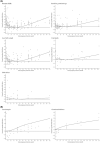Birth spacing and risk of adverse pregnancy and birth outcomes: A systematic review and dose-response meta-analysis
- PMID: 37675816
- PMCID: PMC10619614
- DOI: 10.1111/aogs.14648
Birth spacing and risk of adverse pregnancy and birth outcomes: A systematic review and dose-response meta-analysis
Abstract
Introduction: The association between extreme birth spacing and adverse outcomes is controversial, and available evidence is fragmented into different classifications of birth spacing.
Material and methods: We conducted a systematic review of observational studies to evaluate the association between birth spacing (i.e., interpregnancy interval and interoutcome interval) and adverse outcomes (i.e., pregnancy complications, adverse birth outcomes). Pooled odds ratios (ORs) with 95% confidence intervals (CI) were calculated using a random-effects model, and the dose-response relationships were evaluated using generalized least squares trend estimation.
Results: A total of 129 studies involving 46 874 843 pregnancies were included. In the general population, compared with an interpregnancy interval of 18-23 months, extreme intervals (<6 months and ≥ 60 months) were associated with an increased risk of adverse outcomes, including preterm birth, small for gestational age, low birthweight, fetal death, birth defects, early neonatal death, and premature rupture of fetal membranes (pooled OR range: 1.08-1.56; p < 0.05). The dose-response analyses further confirmed these J-shaped relationships (pnon-linear < 0.001-0.009). Long interpregnancy interval was only associated with an increased risk of preeclampsia and gestational diabetes (pnon-linear < 0.005 and pnon-linear < 0.001, respectively). Similar associations were observed between interoutcome interval and risk of low birthweight and preterm birth (pnon-linear < 0.001). Moreover, interoutcome interval of ≥60 months was associated with an increased risk of cesarean delivery (pooled OR 1.72, 95% CI 1.04-2.83). For pregnancies following preterm births, an interpregnancy interval of 9 months was not associated with an increased risk of preterm birth, according to dose-response analyses (pnon-linear = 0.008). Based on limited evidence, we did not observe significant associations between interpregnancy interval or interoutcome interval after pregnancy losses and risk of small for gestational age, fetal death, miscarriage, or preeclampsia (pooled OR range: 0.76-1.21; p > 0.05).
Conclusions: Extreme birth spacing has extensive adverse effects on maternal and infant health. In the general population, interpregnancy interval of 18-23 months may be associated with potential benefits for both mothers and infants. For women with previous preterm birth, the optimal birth spacing may be 9 months.
Keywords: adverse birth outcome; adverse pregnancy outcome; birth interval; interoutcome interval; interpregnancy interval.
© 2023 The Authors. Acta Obstetricia et Gynecologica Scandinavica published by John Wiley & Sons Ltd on behalf of Nordic Federation of Societies of Obstetrics and Gynecology (NFOG).
Conflict of interest statement
None.
Figures



Similar articles
-
Gestational weight gain below instead of within the guidelines per class of maternal obesity: a systematic review and meta-analysis of obstetrical and neonatal outcomes.Am J Obstet Gynecol MFM. 2022 Sep;4(5):100682. doi: 10.1016/j.ajogmf.2022.100682. Epub 2022 Jun 18. Am J Obstet Gynecol MFM. 2022. PMID: 35728780
-
Interpregnancy interval following miscarriage and adverse pregnancy outcomes: systematic review and meta-analysis.Hum Reprod Update. 2017 Mar 1;23(2):221-231. doi: 10.1093/humupd/dmw043. Hum Reprod Update. 2017. PMID: 27864302
-
Multiple-micronutrient supplementation for women during pregnancy.Cochrane Database Syst Rev. 2017 Apr 13;4(4):CD004905. doi: 10.1002/14651858.CD004905.pub5. Cochrane Database Syst Rev. 2017. Update in: Cochrane Database Syst Rev. 2019 Mar 14;3:CD004905. doi: 10.1002/14651858.CD004905.pub6. PMID: 28407219 Free PMC article. Updated.
-
Treating periodontal disease for preventing adverse birth outcomes in pregnant women.Cochrane Database Syst Rev. 2017 Jun 12;6(6):CD005297. doi: 10.1002/14651858.CD005297.pub3. Cochrane Database Syst Rev. 2017. PMID: 28605006 Free PMC article.
-
Impact of Sjögren's syndrome on maternal and fetal outcomes following pregnancy: a systematic review and meta-analysis of studies published between years 2007-2022.Arch Gynecol Obstet. 2024 Apr;309(4):1135-1149. doi: 10.1007/s00404-023-07259-3. Epub 2023 Nov 3. Arch Gynecol Obstet. 2024. PMID: 37921880
Cited by
-
Interpregnancy maternal weight change is not associated with offspring weight and obesity at age 2 years.Int J Obes (Lond). 2024 Oct;48(10):1402-1413. doi: 10.1038/s41366-024-01554-y. Epub 2024 Jun 13. Int J Obes (Lond). 2024. PMID: 38872055 Free PMC article.
-
Teenage mothers report poor health and economic functioning in Western Kenya: A call to action.PLOS Glob Public Health. 2025 Jul 15;5(7):e0004732. doi: 10.1371/journal.pgph.0004732. eCollection 2025. PLOS Glob Public Health. 2025. PMID: 40663514 Free PMC article.
-
Association of the time interval between first and last birth with obesity in middle-aged postmenopausal Chinese women: a cross-sectional study in southern China.Front Med (Lausanne). 2025 Mar 31;12:1505319. doi: 10.3389/fmed.2025.1505319. eCollection 2025. Front Med (Lausanne). 2025. PMID: 40231077 Free PMC article.
-
Short birth spacing and its impact on maternal and child health in India with urban-rural variation: An epidemiological study using the National Family Health Survey Data.PLoS One. 2025 Jun 27;20(6):e0325461. doi: 10.1371/journal.pone.0325461. eCollection 2025. PLoS One. 2025. PMID: 40577365 Free PMC article.
-
Non-linear association between interpregnancy interval after vaginal delivery and singleton preterm birth: a retrospective cohort study.BMC Pregnancy Childbirth. 2025 Mar 11;25(1):275. doi: 10.1186/s12884-025-07373-x. BMC Pregnancy Childbirth. 2025. PMID: 40069651 Free PMC article.
References
-
- Dorney E, Mazza D, Black KI. Interconception care. Aust J Gen Pract. 2020;49:317‐322. - PubMed
-
- Louis JM, Bryant A, Ramos D, Stuebe A, Blackwell SC. Interpregnancy care. Am J Obstet Gynecol. 2019;220(1):B2‐b18. - PubMed
-
- Organization WH . Report of a WHO Technical Consultation on Birth Spacing: Geneva, Switzerland 13–15 June 2005. World Health Organization; 2007.
-
- Conde‐Agudelo A, Rosas‐Bermúdez A, Kafury‐Goeta AC. Birth spacing and risk of adverse perinatal outcomes: a meta‐analysis. JAMA. 2006;295(15):1809‐1823. - PubMed
Publication types
MeSH terms
Grants and funding
LinkOut - more resources
Full Text Sources
Medical

